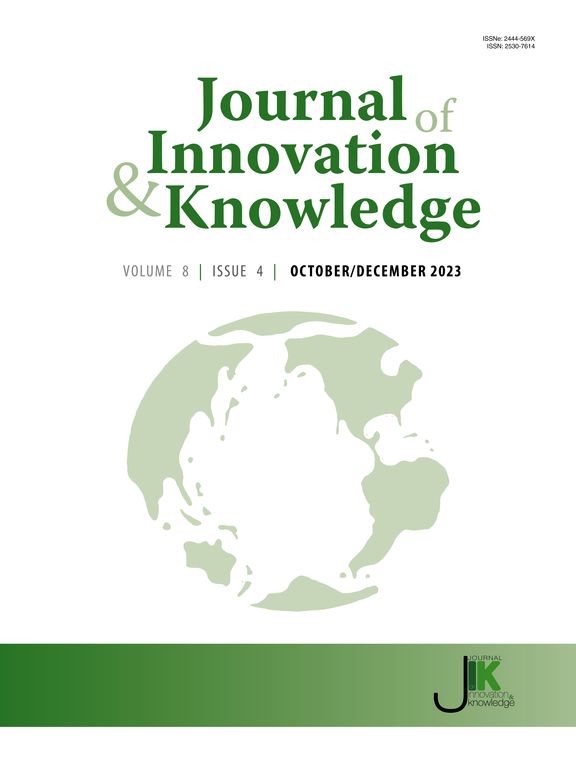通过数字技术嵌入促进企业绿色低碳创新:从被动响应到主动创新
IF 15.5
1区 管理学
Q1 BUSINESS
引用次数: 0
摘要
通过数字化推动绿色低碳创新对实现碳峰值和碳中和目标至关重要,并将加速低碳转型。数字技术嵌入性(DTE)颠覆了传统的商业创新模式,但其引导创新走向低碳技术的能力仍存在争议。本研究基于企业从被动响应到主动变革的创新动机,结合中国绿色低碳专利和技术知识复杂性数据,探讨了DTE对GCI的影响机制和网络溢出效应。研究发现:(1)DTE正向影响GCI,增加GCI的技术知识复杂性。这种效应在技术积累较弱、规模较大、ESG绩效较好的企业和污染较重的企业中尤为明显。(2) DTE通过被动响应渠道的调节作用,迫使企业在政府环境监管、公众环保意识和市场创新转化能力等外部环境压力下选择GCI。(3)积极的创新机制表明,DTE通过提高企业的市场信息获取能力、知识共享与吸收能力和协同创新能力,刺激企业寻求低碳偏倚技术,从而提高GCI。(4)同行溢出和供应链溢出强化了DTE对GCI的正向影响,通过提升产业和供应链内GCI的规模和质量,实现绿色低碳转型。因此,以数字技术为核心战略,多方主体(政府、企业和公众)共同参与,构建绿色智能的创新供应链体系,可以建立一种新的治理模式。本文章由计算机程序翻译,如有差异,请以英文原文为准。
Enhancing enterprises’ green and low-carbon innovation through digital technology embeddedness: From passive response to active innovation
Promoting green and low-carbon innovation (GCI) with digitalization is important to achieve carbon peaking and neutrality goals and would accelerate low-carbon transformation. Digital technology embeddedness (DTE) disrupts traditional business innovation patterns, but its ability to steer innovation toward low-carbon-biased technologies is debated. Based on enterprises’ innovation motivation from passive response to active change, this study explores the impact mechanism and network spillover effect of DTE on GCI by combining data of green and low-carbon patent and technical knowledge complexity in China. The study finds that (1) DTE positively impacts GCI and increases its technical knowledge complexity. This effect is particularly evident in enterprises with weak technology accumulation, large-scale, better ESG performance and heavily polluted enterprises. (2) Through the moderating effect of passive response channels, DTE forces enterprises to choose GCI under external environmental pressure from government environmental regulation, public environmental awareness and market innovation transformation ability. (3) Active innovation mechanisms show DTE stimulates enterprises to seek low-carbon-biased technologies by improving their market information acquisition, knowledge-sharing and absorption, and collaborative innovation abilities, thus improving GCI. (4) Peer spillover and supply chain spillovers strengthen the positive impact of DTE on GCI, resulting in green and low-carbon transformation via improved GCI scale and quality within the industry and supply chain. Hence, a novel governance pattern could be established by using digital technology as a core strategy, with participation of multiple agents (government, enterprises and the public) and creation of a green and intelligent innovative supply chain system.
求助全文
通过发布文献求助,成功后即可免费获取论文全文。
去求助
来源期刊

Journal of Innovation & Knowledge
Multiple-
CiteScore
16.10
自引率
12.70%
发文量
118
审稿时长
37 days
期刊介绍:
The Journal of Innovation and Knowledge (JIK) explores how innovation drives knowledge creation and vice versa, emphasizing that not all innovation leads to knowledge, but enduring innovation across diverse fields fosters theory and knowledge. JIK invites papers on innovations enhancing or generating knowledge, covering innovation processes, structures, outcomes, and behaviors at various levels. Articles in JIK examine knowledge-related changes promoting innovation for societal best practices.
JIK serves as a platform for high-quality studies undergoing double-blind peer review, ensuring global dissemination to scholars, practitioners, and policymakers who recognize innovation and knowledge as economic drivers. It publishes theoretical articles, empirical studies, case studies, reviews, and other content, addressing current trends and emerging topics in innovation and knowledge. The journal welcomes suggestions for special issues and encourages articles to showcase contextual differences and lessons for a broad audience.
In essence, JIK is an interdisciplinary journal dedicated to advancing theoretical and practical innovations and knowledge across multiple fields, including Economics, Business and Management, Engineering, Science, and Education.
 求助内容:
求助内容: 应助结果提醒方式:
应助结果提醒方式:


